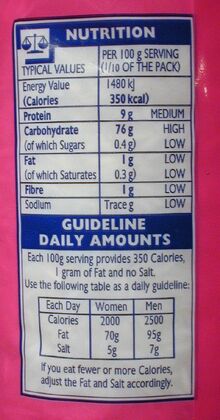Assessment |
Biopsychology |
Comparative |
Cognitive |
Developmental |
Language |
Individual differences |
Personality |
Philosophy |
Social |
Methods |
Statistics |
Clinical |
Educational |
Industrial |
Professional items |
World psychology |
Biological: Behavioural genetics · Evolutionary psychology · Neuroanatomy · Neurochemistry · Neuroendocrinology · Neuroscience · Psychoneuroimmunology · Physiological Psychology · Psychopharmacology (Index, Outline)
Food energy is the amount of energy in food that is available through digestion. The values for food energy are expressed in kilocalories (kcal) and kilojoules (kJ).
One large food Calorie is the amount of digestively available food energy (heat) that will raise the temperature of one kilogram of water one degree Celsius. Some advocate the convention of the capitalizing the C in these so that one Calorie is equal to 1000 lowercase calories, but that is not a convention generally followed, and it is useless when the word starts a sentence. The large Calorie is sometimes abbreviated kcal, to indicate clearly that is 1000 times as large as the calorie. Consequently, the prefix kilo- is not used with large Calories. Food calories are also more specifically called kilocalories on the basis of the small calorie usage. This term, which makes it clear that large Calories are intended, is widely used by professional nutritionists when speaking in terms of calories rather than joules, but the term kilocalorie for 1,000 small calories is less often used by laypersons.
The International System of Units unit kilojoule is becoming more common. In some countries (Australia, for example) only the kilojoule is normally used. Some types of food contain more food energy per gram than others: fats and ethanol have particularly high values for food energy density--- from 7 to 9 kcal/gram. Sugars and proteins have about 4 kcal/gram. One Calorie is approximately equal to 4.1868 kilojoules.
Measuring food energy
In the early twentieth century, the United States Department of Agriculture (USDA) developed a procedure for measuring food energy that remains in use today.
The food being measured is completely burned in a calorimeter so that the heat released through combustion can be accurately measured. This amount is used to determine the gross energy value of the particular food. This number is then multiplied by a coefficient which is based on how the human body actually digests the food.
For example, pure sugar releases about 3.95 kilocalories per gram (16.5 kJ/g) of gross energy but the digestibility coefficient of sugar is about 98% in humans, so the food energy of sugar is 0.98 × 3.95 = 3.87 kilocalories per gram (16.2 kJ/g) of sugar. Note, the digestibility coefficient is likely to vary between individuals based on genetic predisposition, and possibly may be affected by state of physical fitness of the individuals measured, but the mean digestibility for most people is around 98%.
Nutrition and food labels
The "Calorie" has become a common household term, because dietitians recommend in cases of obesity to reduce body weight by increasing exercise (energy expenditure) and reducing energy intake. Many governments require food manufacturers to label the energy content of their products, to help consumers control their energy intake. In Europe, manufacturers of prepackaged food must label the nutritional energy of their products in both kilocalories ("kcal") and kilojoules ("kJ"). In the United States, the equivalent mandatory labels display only "Calories" (when used with capitalized C, meaning kilocalories); an additional kilojoules figure is optional and is rarely used. The energy content of food is usually given on labels for 100 g and/ or for what the manufacturer claims is a typical serving size.
The amount of food energy in a particular food could be measured by completely burning the dried food in a bomb calorimeter, a method known as direct calorimetry [1]. However, the values given on food labels are not determined this way, because it overestimates the amount of energy that the human digestive system can extract, by also burning dietary fiber. Instead, standardized chemical tests and an analysis of the recipe are used to estimate the product's digestible constitutents (protein, carbohydrate, fat, etc.). These results are then converted into an equivalent energy value based on a standardized table of energy densities:
| food component | energy density[2] | |
|---|---|---|
| kcal/g | kJ/g | |
| fat | 9 | 37 |
| ethanol (alcohol) | 7 | 29 |
| proteins | 4 | 17 |
| carbohydrates | 4 | 17 |
| organic acids | 3 | 13 |
| Sugar alcohols (sweeteners) | 2.4 | 10 |
Other substances found in food (water, non-digestible fibre, minerals, vitamins) do not contribute to this calculated energy density.
Recommended daily energy intake values for young adults are: 2500 kcal/d (10 MJ/d, 120 W) for men and 2000 kcal/d (8 MJ/d, 100 W) for women. Children, sedentary and older people require less energy, physically active people more.
About 3,500 calories adds up to about 1 pound. This applies whether they are food calories coming in, or calories (burned by exercise) going out.
If you eat 3,500 calories more than your body needs, you will put on about 1 pound. If you use up 3,500 calories more than you eat, you will lose about 1 pound in weight.
See also
- Food chain
- Atwater system
References
- ↑ http://www.merck.com/mmhe/sec12/ch152/ch152e.html
- ↑ (1997). Nutrient Value of Some Common Foods. Health Canada, PDF p. 4. URL accessed on 2006-03-04.
- de:Brennwert#Physiologischer Brennwert
- ja:生理的熱量
- pl:Wartość energetyczna
| This page uses Creative Commons Licensed content from Wikipedia (view authors). |
